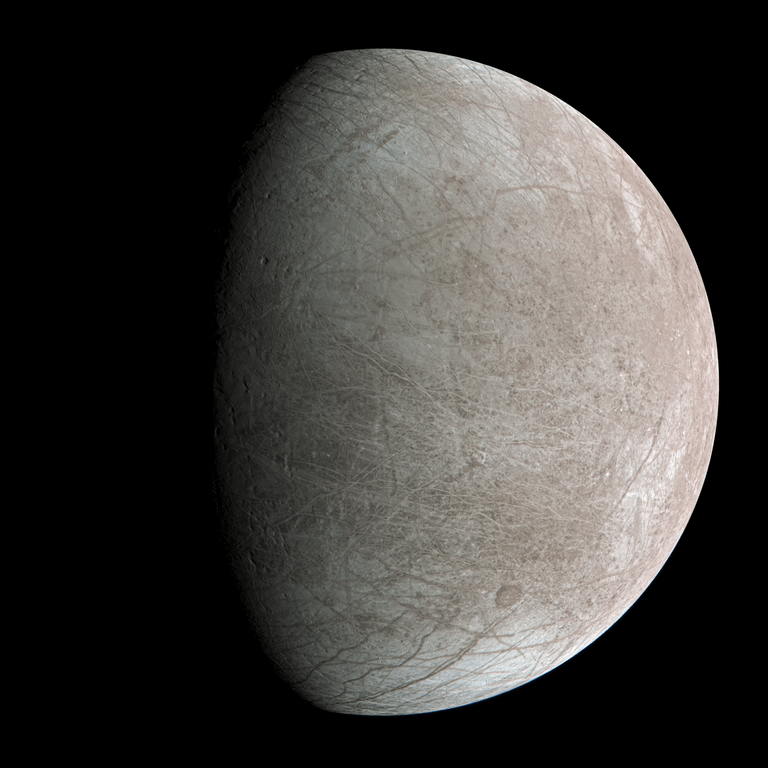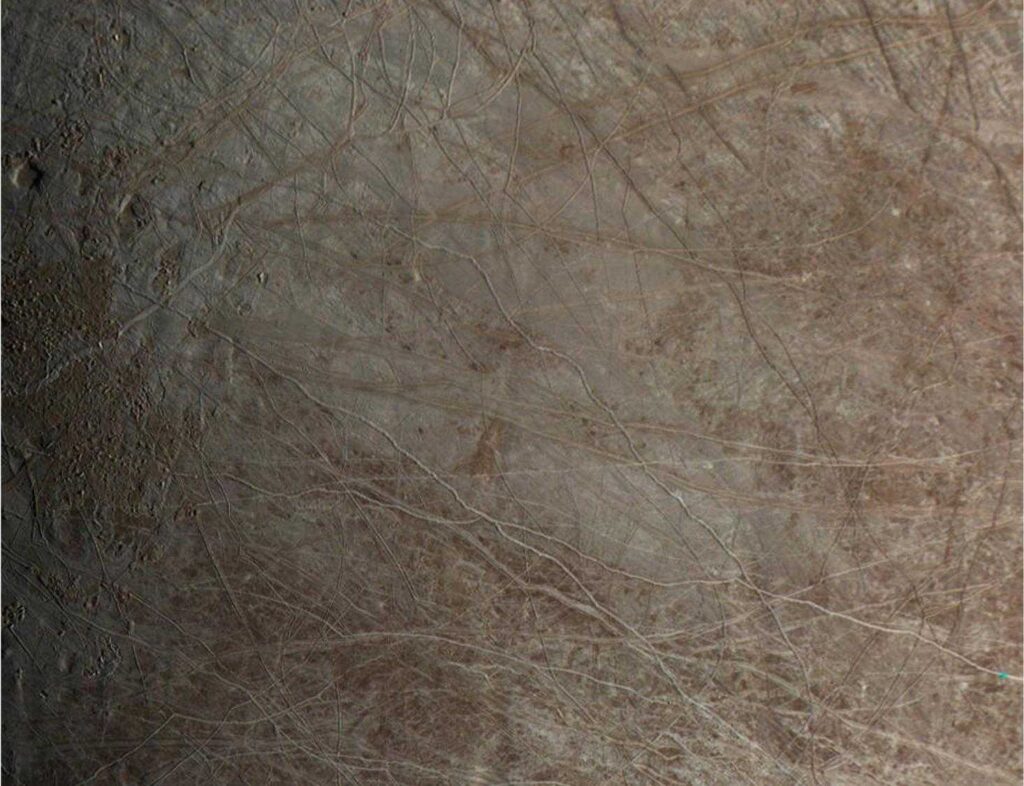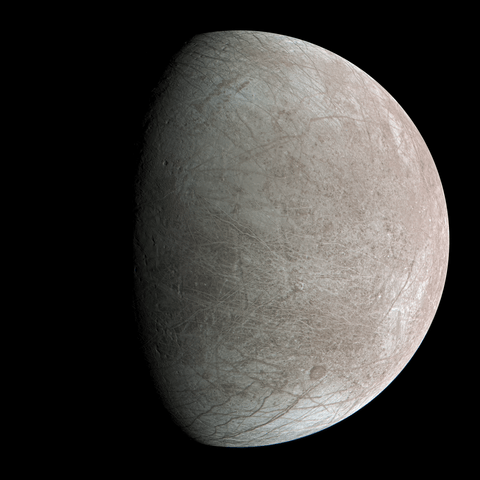Europa, or Jupiter II, is the smallest of the four Galilean moons orbiting Jupiter, and the sixth-closest to the planet of all the 80 known moons of Jupiter. It is also the sixth-largest moon in the Solar System.
View on Google Maps: google.com/maps/space/europa
Orbital period: 85 hours
Radius: 1,560.8 km
Density: 3.01 g/cm³
Distance to Earth: 628.3 million km
Gravity: 1.315 m/s²
Apparent magnitude (V): 5.29

List of facts
Europa is also knwon as Jupiter II,
Europa is the smallest of the four Galilean moons orbiting Jupiter
Europa is the sixth-closest to the planet of all the 80 known moons of Jupiter.
It is also the sixth-largest moon in the Solar System.
Europa was discovered in 1610 by Galileo Galilei
It was named after Europa, the Phoenician mother of King Minos of Crete and lover of Zeus
Europa is primarily made of silicate rock and has a water-ice crust and probably an iron–nickel core
It has a very thin atmosphere, composed primarily of oxygen.
Its white-beige surface is striated by light tan cracks and streaks, but craters are relatively few.
Europa has the smoothest surface of any known solid object in the Solar System.
The Galileo mission, launched in 1989, provides the bulk of current data on Europa
Europa orbits Jupiter in just over three and a half days, with an orbital radius of about 670,900 km
Europa is tidally locked to Jupiter

Europa is about 4.5 billion years old, however it’s surface is only around 20 to 280 million years old.
Europa is slightly smaller than the Moon at just over 3,100 kilometres (1,900 mi) in diameter
The duration of a Europan day is approximately 3.5 times that of a day on Earth
The ionizing radiation level at the surface of Europa is equivalent to a dose of about 5.4 Sv (540 rem) per day
The ionizing radiation level would cause death in human beings exposed for a single Earth-day (24 hours)
Europa’s most striking surface features are a series of dark streaks crisscrossing the entire globe, called lineae
The temperature on Europa varies from −160 °C at the equatorial line, to −220 °C at either of its poles
Europa has no wind, precipitation, or presence of sky color as its gravity is too low to hold an atmosphere substantial enough for these phenomena
Europa’s gravity is approximately 13% of Earth’s
the rocky interior of Europa is surrounded by a layer of ice that is approximately 62 miles thick.
In 2022, the Juno orbiter flew by Europa at a distance of 352 km (219 mi)
Clay-like minerals, often associated with organic matter on Earth, have been detected on the icy crust of Europa
The Hubble Space Telescope detected water vapor plumes on Europa these are thought to be caused by erupting cryogeysers.
Europa information
Discovery |
|||||||||
|---|---|---|---|---|---|---|---|---|---|
| Discovered by | Galileo Galilei Simon Marius |
||||||||
| Discovery date | 8 January 1610 | ||||||||
| Designations | |||||||||
|
Named after
|
Ευρώπη Eurōpē | ||||||||
|
Alternative names
|
Jupiter II | ||||||||
| Adjectives | Europan | ||||||||
Orbital characteristics |
|||||||||
| Epoch 8 January 2004 | |||||||||
| Periapsis | 664862 km | ||||||||
| Apoapsis | 676938 km | ||||||||
|
Mean orbit radius
|
670900 km | ||||||||
| Eccentricity | 0.009[5] | ||||||||
|
Orbital period (sidereal)
|
3.551181 d | ||||||||
|
Average orbital speed
|
13743.36 m/s | ||||||||
| Inclination | 0.470° (to Jupiter’s equator) 1.791° (to the ecliptic) |
||||||||
| Satellite of | Jupiter | ||||||||
| Group | Galilean moon | ||||||||
Physical characteristics |
|||||||||
|
Mean radius
|
1560.8±0.5 km (0.245 Earths) | ||||||||
|
Surface area
|
3.09×107 km2 (0.061 Earths) | ||||||||
| Volume | 1.593×1010 km3 (0.015 Earths) | ||||||||
| Mass | (4.799844±0.000013)×1022 kg (0.008 Earths) | ||||||||
|
Mean density
|
3.013±0.005 g/cm3 (0.546 Earths) | ||||||||
|
Surface gravity
|
1.314 m/s2 (0.134 g) | ||||||||
|
Moment of inertia factor
|
0.346±0.005 (estimate) | ||||||||
|
Escape velocity
|
2.025 km/s | ||||||||
|
Synodic rotation period
|
Synchronous | ||||||||
|
Axial tilt
|
0.1° | ||||||||
| Albedo | 0.67 ± 0.03 | ||||||||
|
|||||||||
|
Apparent magnitude
|
5.29 (opposition) | ||||||||
| Atmosphere | |||||||||
|
Surface pressure
|
0.1 µPa (10−12 bar) | ||||||||

